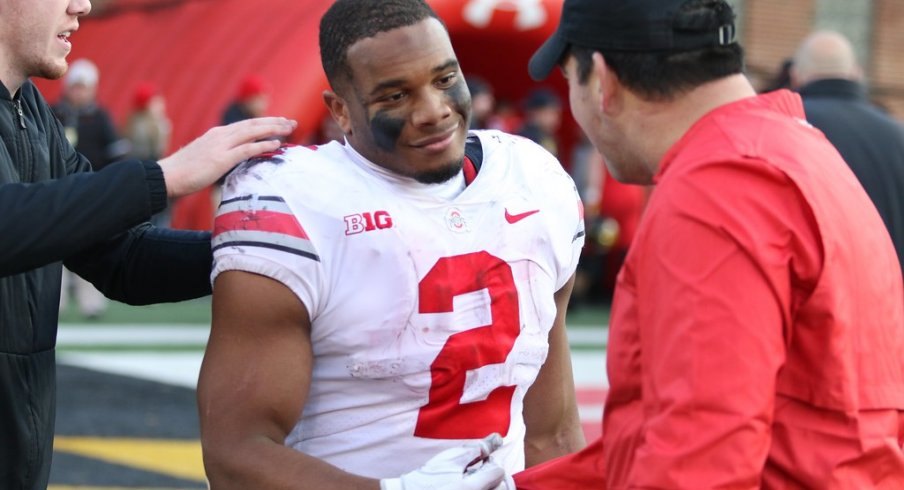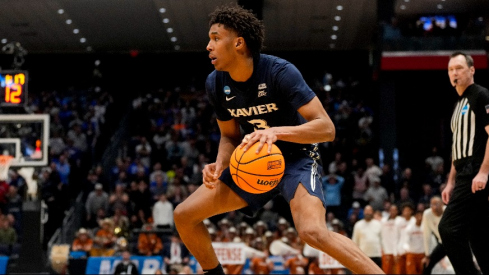Starting with a week one date with Lane Kiffin and Florida Atlantic, it will be apparent early what Ohio State's offense is going to look like in 2019.
After Dwayne Haskins rewrote the Buckeye record books in his one season as a starter, Ryan Day was able to reel in elite transfer Justin Fields, who will look to continue the dominant quarterback play that Haskins exhibited a year ago.
Understatement: @OhioStateFB frosh WR @GarrettWilson_V's gonna be special. pic.twitter.com/WyoaBG2ONO
— Ohio State on BTN (@OhioStateOnBTN) April 13, 2019
Young, old and talented is the mix at the skill positions, and that's ideal overall. The Buckeyes will be led by veterans at running back (J.K. Dobbins), wide receiver (K.J. Hill, Binjimen Victor and Austin Mack) and tight end (Luke Farrell). Behind the veterans, however, sit talented young guns including Master Teague, Garrett Wilson and Jeremy Ruckert.
Great teams feature a mix exactly like the Buckeyes have, and it will be interesting to see how it plays out in 2019. With that, let's take a look at the best- and worst-case scenarios for Ohio State's offense for the upcoming season.
Best Case
Ohio State has a relatively easy schedule for the beginning of the season, which could give the offense the gel time it needs to be an elite unit.
Outside of Fields, the Buckeyes do not have much depth at quarterback. Backup Matthew Baldwin will be a redshirt freshman who has never played a collegiate snap in a regular season game. Fields staying healthy (much like Haskins last year) will be paramount to Ohio State's success.
During the 2019 season, there were moments where the Ohio State ground game was virtually non-existent. J.K. Dobbins rushed for 7.2 ypc during his freshman season, but that plummeted down to 4.6 in 2018. With a revamped offensive line and a dual-threat quarterback, it will be key for Dobbins to improve on those numbers. If he can do that, it will open up the passing game nicely for the Buckeyes, which will bring with it more opportunities to move the football and score.
The best case scenario also involves Binjimen Victor and Austin Mack exploding during their final seasons. We all know the steady hand that K.J. Hill will bring, but Victor and Mack have been wildly inconsistent at times. We know what they both can do, but they need to put it all together for a young quarterback who will need all the weapons he can get.
What a play @BinjimenVictor pic.twitter.com/8AqOfKI4n9
— Buckeye Videos+ (@BuckeyeVideos) September 30, 2018
In 2018, Mack's season was cut short due to an injury. Him having a bounceback year (in his last season of eligibility) will be absolutely key.
Great teams also find ways to get key production from other sources, and the tight end is one of those. Ohio State has neglected (or seemed to) the position in recent years, but veteran Luke Farrell and the much heralded Jeremy Ruckert (in addition to the athletic but inconsistent Rashod Berry) provide a surplus of talent at the position. If Ohio State wants to have success, they need to use the tight end well.
Heading into 2019, the Buckeyes will also have to replace four offensive line starters. Ryan Day brought in Jonah Jackson from Rutgers to fill one spot, but the rest will be stocked by highly recruited home-grown talent, such as Josh Myers and Wyatt Davis. Branden Bowen returns from injury to provide more depth, and Joshua Alabi will be a good option at swing tackle. But it is always hard to replace four starters from one unit, and it will be imperative for this line to protect Fields and provide holes for Dobbins.
Tremendous, right? Sounds easier than it is. But if Ohio State wants to have success in 2019, Fields has to stay healthy, there has to be a good run-pass balance, the senior wide receivers have to go out with a bang, and the offensive line must be stalwart. That is the best-case scenario.
Worst Case
At the surface, it's obvious that the worst-case scenario would be Fields getting injured. That would be a drastic blow that would likely spell the end of any playoff hopes that Ohio State has (unless Matthew Baldwin turns in an elite performance in relief).
Underneath, there are a bunch of smaller factors that could lead to doom for the offense in 2019.
Directly correlating to 2018, J.K. Dobbins regressing (or even staying at the same level) would be a major disaster. As mentioned earlier, Ohio State needs the run to open up the pass. With Fields' dual-threat capabilities, that should be possible, but Dobbins needs to step up as well.
Replacing four starters, as also mentioned, is very hard. If the new guys on the offensive line do not develop as expected, it will be very rough for a quarterback who has not started a college football game.
Even the wide receivers have a say in this. Brian Hartline looked awfully good in his first season as the leader of that unit, but will he go through a sophomore slump, or will the development train continue?
In conclusion, Ohio State has the potential to have major success or a major regression on the offensive side of the ball in 2018. Replacing elite talent (Ohio State returns just three starters on the offensive side of the ball: Dobbins, Farrell and Thayer Munford) is always hard, and it will be interesting to see how Ohio State handles it.


